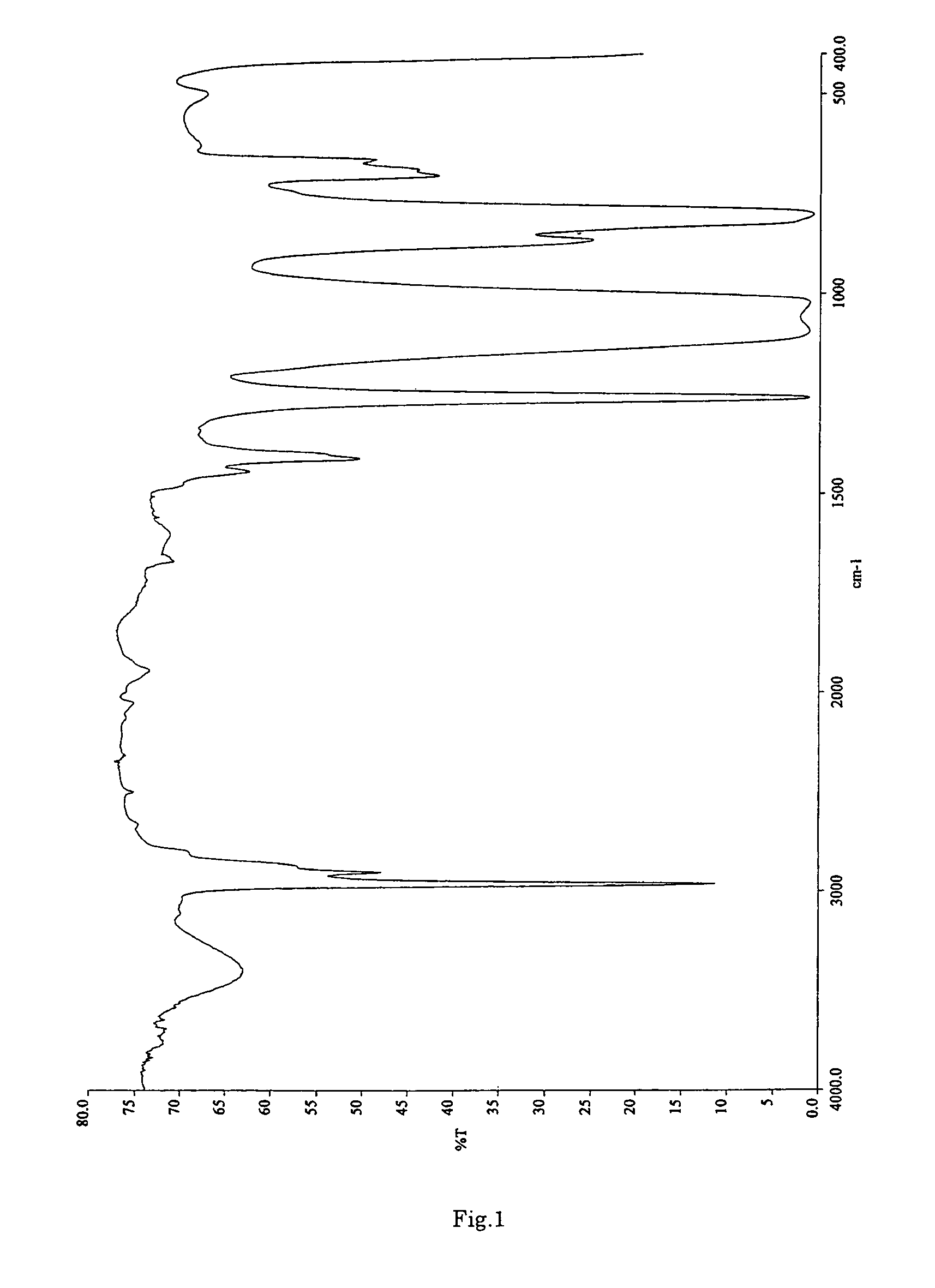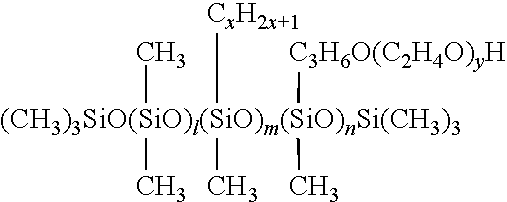Alternating copolymer of organopolysiloxane with grycerol derivative and a cosmetic comprising the same
a technology of organopolysiloxane and glycerol derivative, which is applied in the direction of hair cosmetics, transportation and packaging, make-up, etc., can solve the problems of affecting the application effect, so as to improve the flatness, smoothness and abrasion resistance of the applied paint, and reduce the tackiness. , the effect of preventing blockag
- Summary
- Abstract
- Description
- Claims
- Application Information
AI Technical Summary
Benefits of technology
Problems solved by technology
Method used
Image
Examples
example 1
Preparation of Alternating Copolymer 1
[0106]In a reactor, 200 g of methylhydrogenpolysiloxane represented by the following average compositional formula, 256 g of triglycerol dially ether, 400 g of isopropyl alcohol (IPA), and 0.9 g of a 0.5 wt % solution of chloroplatinic acid in IPA were placed and subjected to a reaction for 8 hours while refluxing IPA.
[0107]
[0108]After cooling, the reaction mixture liquid was transferred to an autoclave to which 15 g, weighed in water, of Raney nickel was added. Then, hydrogen gas was introduced in the autoclave and a reaction was carried out at 120 degrees C. for 3 hours while maintaining a pressure of the hydrogen gas at 0.5 MPa. After removing the catalyst by filtration, the reaction mixture was subjected to vacuum distillation to remove volatile substances. The organopolysiloxane / polyglycerol alternating copolymer thus obtained was clear and colorless liquid having a viscosity of 39 Pa·s and a refractive index of 1.4576, both at 25 degrees C...
example 2
Preparation of Alternating Copolymer 2
[0109]In a reactor, 300 g of methylhydrogenpolysiloxane represented by the following average compositional formula, 143 g of triglycerol dially ether, 300 g of isopropyl alcohol (IPA), and 0.75 g of a 0.5 wt % solution of chloroplatinic acid in IPA were placed and subjected to a reaction for 8 hours while refluxing IPA.
[0110]
[0111]After cooling, the reaction mixture liquid was transferred to an autoclave to which 15 g, weighed in water, of Raney nickel was added. Then, hydrogen gas was introduced in the autoclave and a reaction was carried out at 120 degrees C. for 3 hours while maintaining a pressure of the hydrogen gas at 0.5 MPa.
[0112]After removing the catalyst by filtration, the reaction mixture was subjected to vacuum distillation to remove volatile substances. The organopolysiloxane / polyglycerol alternating copolymer thus obtained was clear and colorless liquid having a viscosity of 24 Pa·s and a refractive index of 1.4345, both at 25 deg...
example 3
Preparation of Alternating Copolymer 3
[0113]In a reactor, 300 g of methylhydrogenpolysiloxane represented by the following average compositional formula, 67 g of triglycerol diallyether, 300 g of isopropyl alcohol (IPA), and 0.75 g of a 0.5 wt % solution of chloroplatinic acid in IPA were placed and subjected to a reaction for 8 hours while refluxing IPA.
[0114]
[0115]After cooling, the reaction mixture liquid was transferred to an autoclave to which 15 g, weighed in water, of Raney nickel was added. Then, hydrogen gas was introduced in the autoclave and a reaction was carried out at 120 degrees C. for 3 hours while maintaining a pressure of the hydrogen gas at 0.5 MPa.
[0116]After removing the catalyst by filtration, a little amount of aldehydes were decomposed with hydrochloric acid. Then, the reaction mixture was neutralized and subjected to vacuum distillation to remove volatile substances. The organopolysiloxane / polyglycerol alternating copolymer thus obtained was clear and colorl...
PUM
| Property | Measurement | Unit |
|---|---|---|
| pressure | aaaaa | aaaaa |
| viscosity | aaaaa | aaaaa |
| refractive index | aaaaa | aaaaa |
Abstract
Description
Claims
Application Information
 Login to View More
Login to View More - R&D
- Intellectual Property
- Life Sciences
- Materials
- Tech Scout
- Unparalleled Data Quality
- Higher Quality Content
- 60% Fewer Hallucinations
Browse by: Latest US Patents, China's latest patents, Technical Efficacy Thesaurus, Application Domain, Technology Topic, Popular Technical Reports.
© 2025 PatSnap. All rights reserved.Legal|Privacy policy|Modern Slavery Act Transparency Statement|Sitemap|About US| Contact US: help@patsnap.com



